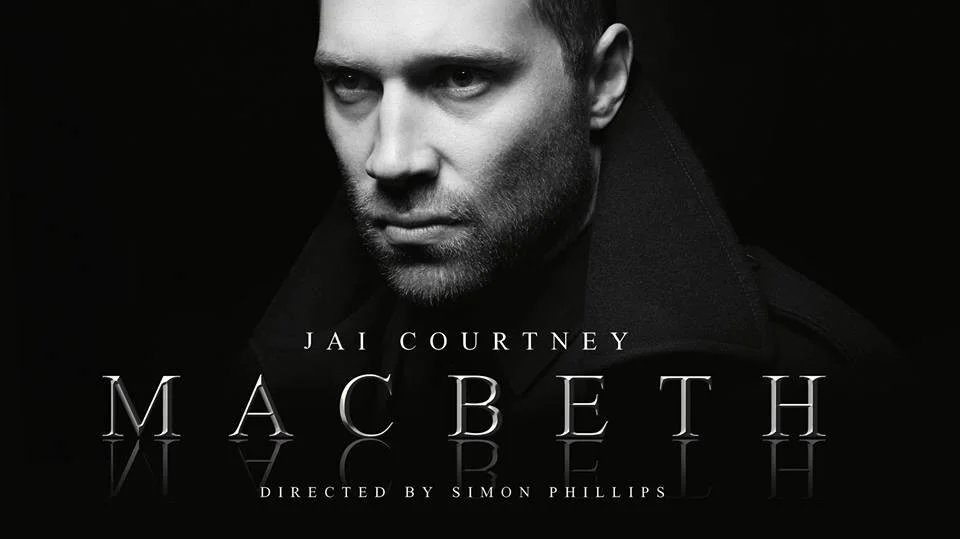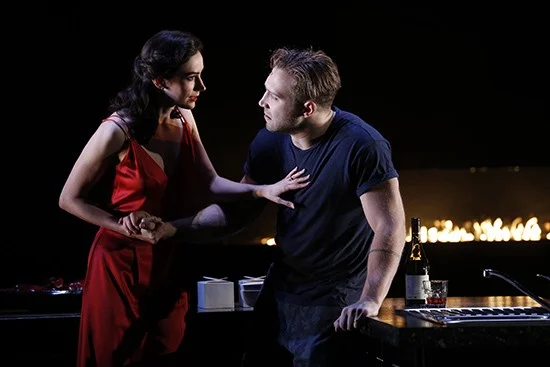Poster for Macbeth featuring Jai Courtney, as seen around Melbourne
This is Director Simon Phillips’s second Macbeth for the MTC. It ought to be recognised as a great and bold production and celebrated for its quintessentially Australian scepticism towards authority and tradition. It has the potential to guide generations more comfortable with the conventions of cinema into the orbit of both Shakespeare and the theatre respectively. It does so without sacrificing any of the majesty of the original verse, the richness of the themes or quality of the acting. After an enthralling 110 minutes without interval, the principal feeling one is left with at the end of Phillips’s Macbeth is sheer enjoyment at having been so entertained.
The recruitment of Jai Courtney (Macbeth), of Divergent (2014) and Suicide Squad (2016) fame, was a masterstroke in casting. He is the latest in the rich vein of Australian exports, such as Russell Crowe and Sam Worthington, who have ridden into Hollywood on the back of their rugged masculinity and natural acting abilities. Courtney perfectly aligned the dramaturgy of the production with what was effectively a Hollywood blockbuster on stage. Such a cinematic production is not a wholly unchartered territory for the MTC. Director Simon Phillips has reprised the tenor of his MTC 2005 King Lear(starring the late Frank Gallacher as Lear) which similarly captured a larger than life aesthetic, with its on-stage waterfall and cars and motorbikes.
Jai Courtney (Macbeth), Kevin Hofbauer (Banquo), Kamil Ellis, Shareena Clanton and Jane Montgomery Griffiths (the three witches), photograph by Jeff Busby
One would be mistaken to deride this production for its overwrought Hollywood features, such as Ian McDonald’s score, which was effective but somewhat trite, or to obsessively dwell on the incongruity of Courtney’s unburnished Australian accent with the complexities of Shakespearean verse. Instead, it is instructive to embrace Phillips’s Macbeth on its own terms, informed by an understanding of how it is communing with other distinctly Australian productions of Macbeth such as Geoffrey Wright’s (2006) and Justin Kerzer’s (2015). Each of these films can be said to have influenced the gritty, sparse and devastated industrial space which Phillips has created. With this understanding in place, one can more fully appreciate Phillips’s deep understanding of the sense of Shakespeare, and the character of Macbeth with all his soldierly limitations. No, this is not Prince Hamlet, nor was meant to be. This is Macbeth, as Shakespeare would have had him. A brutish and physical soldier-king more comfortable with the imperatives of action than with rambling philosophical deliberations and the decorum and power-politics of the royal court.
Shaun Gurton was innovative and quite brilliant as set director. Phillips made much use of Gurton’s revolving stage, which not only facilitated seamless transitions between scenes and acts but also had the effect of creating depth and component parts within individual scenes. The stage rotated clockwise when the fates were working in Macbeth’s favour, and as the play hurtled towards the end of its tragic arc, the stage (as Wheel of Fortune) turned anti-clockwise. Artistically, one of Gurton’s most arresting images was in Act 3, when a dashing Macbeth — in black leather riding boots and with whip in hand — commissions the murders of Banquo and Fleance. Set in an equestrian stable, the audience are confronted with a backdrop of heavy black boxes (resembling coffins) interspersed with roughly ten steel poles standing erect. Two saddles hang on each pole, one stacked over the other with stirrups akimbo. The chilling effect rendered is that of human corpses hanging in the background behind Macbeth and the murderers, foreshadowing the bloodshed to come. This is but one example of Gurton perfectly capturing the macabre, tense, and dark nature of the play’s moral universe.
Esther Marie Hayes also deserves special tribute for her inspired and detailed efforts as Costume Designer, which were distinguished by the array of textures and colours befitting such a foreboding production. Of note were the elegant dresses and silken jumpsuits of Lady Macbeth, the robust military fatigues of the soldiers, the resplendent royal garb of the nobles, and the grungy black coats and leathers for the homeless — but very Melbourne — three witches.
Geraldine Hakewill (Lady Macbeth) and Jai Courtney (Macbeth), photograph by Jeff Busby
Geraldine Hakewill is a revelation as Lady Macbeth and was enchanting and compelling on stage. From the outset, the audience was every bit as under her spell as was Macbeth, seduced by the lustre of her red silken jumpsuit, her celestial physique and perfect diction. A contemporary of Courtney’s at WAAPA, one could detect the pair’s natural affection and comfortability with each other poured into their roles on stage. The young Hollywood power couple exuded an irresistible physical attraction for one another, and for power. Dan Spielman (Macduff) served brilliantly as an austere and rough foil to Courtney. This was to be expected, given his experience as Macbeth in Bell Shakespeare’s 2012 production.
Theatre has an ability to polarize people, especially Shakespeare enthusiasts. This production has certainly done that. It must also be said that theatre can struggle to engage those not familiar with plays, poetry, literature and music. These great swathes of people — old and young — too often become disengaged, and Phillips’s Macbeth represents an excellent bridge for these demographics to immerse themselves in Shakespeare and the theatre. Simon Phillips’s production of Macbeth has the rare ability to transfix all members of the audience for different reasons, whether it be the sublime quality of the set and costumes, the rawness and strength of the acting, or the overall ‘Hollywood’ production values. Inevitably, there are faults to find, but the positives of the production far outweigh its shortcomings. Bravo, MTC.


